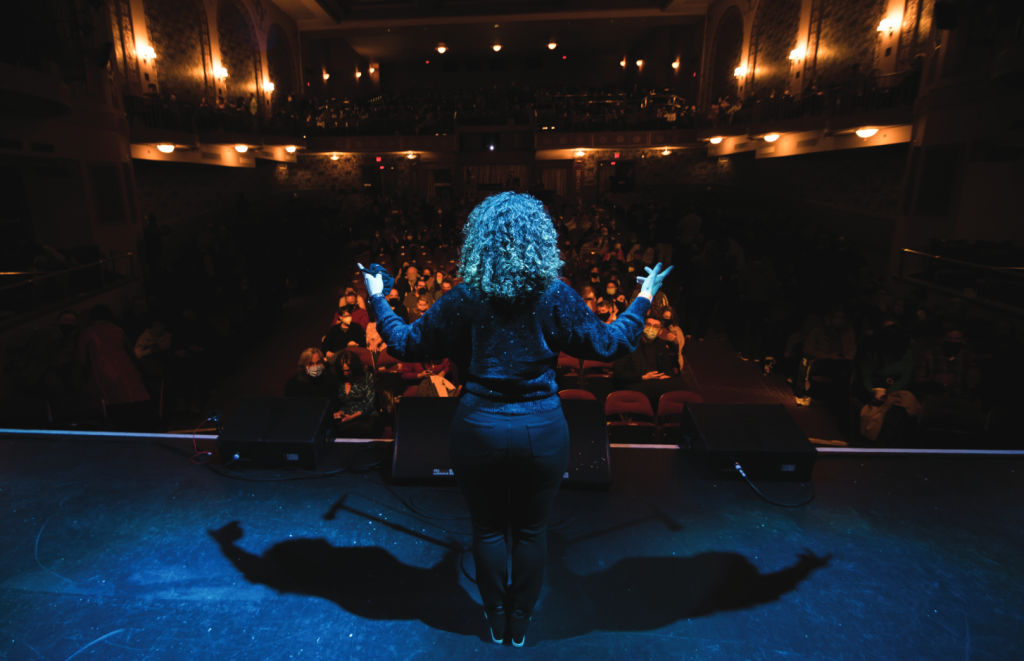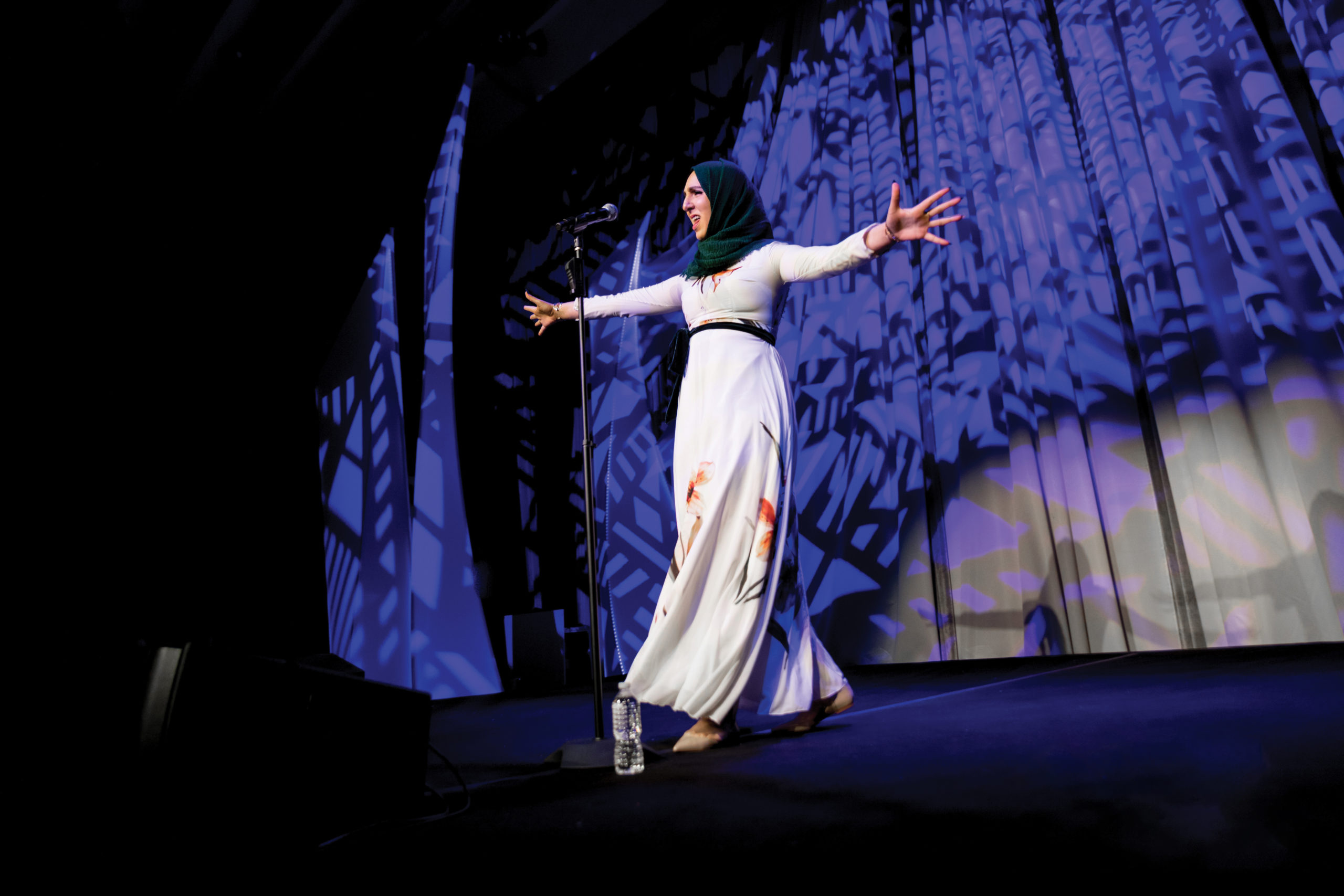Culture
 Amy Saidman introducing a show. Photo by Shedrick Pelt.
Amy Saidman introducing a show. Photo by Shedrick Pelt.
I Did It for the Story: Story District on 25 Years of Storytelling
September 1, 2022 @ 12:00pm
This October, Story District celebrates 25 years of putting storytelling centerstage. Over the past few decades, Story District has helped D.C. residents shape their stories into art, turning even the most casual anecdote into a moment worth remembering. I talked with Amy Saidman, artistic executive director of Story District, over Zoom about how the organization has changed and grown. Behind Saidman was a poster of two people jumping between high-rise buildings with the fitting words, “I did it for the story.”
I’m struck — or maybe hyper-aware — by how often our conversation veers into storytelling. It’s like cultural currency; I share a piece of me, she shares a piece of her. We empathize by trading stories, building on what it means to feel the way we do, finding out someone else might understand. In D.C., where the population is vast, transient and multicultural, storytelling is even more necessary to build a shared community.
“I’ve had people say to me it was Story District that gave them a place of belonging in D.C.,” Saidman says. “Hearing from other Washingtonians gave them a sense of where they fit into the bigger story.”
Once Upon a Time…
Originally started in 1997, Story District was known as The Speakeasy, an open mic event that allowed people to tell stories on stage, under the umbrella of Washington Storytellers Theatre (WST). The concept took off, growing alongside other storytelling communities like “The Moth” and the National Storytelling Festival.
Saidman got involved with The Speakeasy in 1999 running monthly events. The Speakeasy was held at HR-57, a now-closed jazz and blues club on 14th Street. Events were casual, potluck-style. Participants brought food and wine, and those who wanted to tell a story put their name on a sign-up sheet. The stage held a piano, brick walls enclosed the space and the roof had a slight leak. At that point, WST was at a crossroads deciding if they should continue or shut down.
“I was like, ‘Should I do this?’” Saidman says. “At the time, The Speakeasy was pretty small; around 100 people would attend. [I realized] we were outgrowing the space.”
Saidman had ideas for how to grow and organize each event. And so came Story District’s climactic turn.
“I went and made the case: Don’t shut this down. Hand it over to me.”
As she took over, continuing to run events, she noticed people’s storytelling skills were hit or miss. Saidman implemented stop times for stories — a cap at seven minutes each to help people get to the arc of their story quicker. This planted the seed of an idea: Coaching could help people tell their stories in the most effective way possible.
Their first attempt at coaching was a six-week storytelling class. Storytelling 101, headed by seasoned storytelling coaches, teaches key skills like how to create a narrative arc, strategies for establishing what’s at stake and ways to develop a scene.
“Our classes give one-on-one, personalized instruction,” says Story District’s marketing and digital content director Lou Keeton. “Our students build confidence and gain a sense of belonging.”
The classes grew bigger; the demand got higher. Story District started offering six-week storytelling classes and added one-day boot camps. Events became more polished. They moved to a bigger space, and then another bigger space, and then even bigger spaces within the other spaces.
Soon after, different businesses inquired about running storytelling classes for professional development.
They had some good experiences, and some less productive. For instance, Saidman helped people at a microloan company discover how their personal stories can move people to care about their mission and believe in their impact. But she was also invited to a conference where no matter what method she tried, she could not get participants to engage.
“I did all this work to prepare for this Amnesty International conference,” Saidman says. “I thought origin stories were a good place to start: ‘Why are you doing this work?’ I didn’t think to ask who was in attendance — they were all young, college students.”
The students didn’t know how to communicate why their story was important. They talked about their majors, or why they might switch majors.
“I was stuck,” Saidman says. “I wasn’t experienced yet. Now, I could probably handle it. But then, they didn’t know the mission of the conference. They didn’t really choose to be there. It was a good lesson for me to know my audience.”
The Story District team started to implement ideas on the intent behind storytelling, eventually coaching dozens of organizations around the District, including Sierra Club, American University’s Kogod School of Business and the State Department, among others, to reach their audiences effectively.
“The [audience is] there, ready to listen,” Saidman says. “Sometimes I’m tough on the storytellers because I feel an even greater responsibility to the audience in some ways.”

Amy Saidman. Photos by Andrew J. Williams III.
A New Chapter
Storytelling is often associated with children’s events, but Story District reclaims the term; it’s an art form — a way for humans of all ages to express themselves. To represent the organization’s evolution into a local arts institution, the name Story District was adopted in 2015.
Still, Saidman wants storytellers to know even though these are artful performances, the goal is to tell stories in a way that is personable, conversational and most importantly, authentic. It should allow the storyteller to be themselves as much as possible.
“We focus on the content more than the performance,” Saidman says. “[We want our storytellers to] own their stories.”
They began partnering with organizations and individuals like Team Rayceen Productions (TRP) for the annual LGBTQ show “Out/Spoken,” and comedian Yasmin Elhady for “Which Way is Mecca?” — an annual show showcasing Muslims in America.
“Whatever the story, I admire how brave that person is to share something so personal with the audience,” TRP creative director and founder Zar says. “D.C. is segregated in many ways and it’s helpful for people to understand what others experience, especially those from other demographics.”
“Story District has helped many Muslims from my community feel like their stories matter,” Elhady adds. “It has given training and offered insight to make stories into true presentations of the Muslim American experience.”
No matter where a person is from, certain universal themes really stick, like the “worst ever” series. The series has included worst dates, worst jobs, worst mistakes and more, but unlike some other storytelling events, there’s no competition for who tells the best story.
“We want everybody to be the best versus individuals competing against one another,” Saidman says. “We have our cast; we meet in advance to work on stories in rehearsal. You build these long-lasting relationships and are rooting for each other on the night of the show.”
One caveat: People do win for the worst experience, and the prize is a golden plunger.
“It’s a silly competition,” Saidman says. “No one feels like their story isn’t good enough.”
The best show involves stories that are both funny and poignant, Saidman claims. Story District works to incorporate many different perspectives around the set theme. Though everyone loves comedy and fun, people appreciate a mix. Our stories reflect our realities — it’s most authentic to showcase different experiences.
“The entire endeavor is about connection,” Elhady says. “I have laughed, cried, learned and been surprised by the stories I have heard at Story District. A good story has the power to totally change perspectives and transform lives.”
The Resolution
“Our mission is not just to create a space where people share their stories, which I think of as like a support group,” Saidman says. “Our mission is to help people tell their stories artfully so they can be effective with their message and capture their audience.”
The past 25 years, Story District has done just that, showing people how to become great storytellers and how to apply storytelling to one’s life and work. There’s an aspect to believing in your own story, no matter how mundane — in giving it the time and space to evolve and be told artfully.
“If we are the stories we tell ourselves, then the stories we’re telling from D.C. are contributing to our identity as a city,” Keeton says. “The voices we’re sharing here in the heart of the United States are stories that will impact our country. So, we have a responsibility in this space to amplify those stories.”
“I think D.C. is home to some of the brightest, most diverse people in the world,” Elhady adds. “Story District benefits from this city’s expansive network of professionals, artists, authors and scholars. Each show highlights [D.C.’s] beautiful diversity.”
Along with anyone who wants to give it a go, Story District has hosted notable names like Ezra Klein, Alix Spiegel, Carla Hall, Alexandra Petri and Kwame Onwuachi, among other local favorites like Jay Dev, Diana Veiga and Mike Kane.
Despite the big names, Story District reminds us we’re all just people: Humans who live very human lives. The sheer commonplaceness of storytelling can trip people up; we wonder if our stories are worth telling.
“It’s like the two D.C.s thing — [politicians] on Capitol Hill and people just living their lives,” Saidman says. “These are the real-life stories we tell.”
“We’re going to continue to grow past 25 years,” Keeton says.
“To give a sense of what D.C. is and where you fit in it,” Saidman adds.
Story District’s own story is rooted in D.C., in a place and people real and nuanced. The plot has ebbed and flowed; climactic moments have left residents on the edge of their seats. The cast of characters changes but each leaves a lasting impression, setting the stage for whomever, or whatever, might come next.
Story District is celebrating its 25th anniversary on October 1 at Lincoln Theatre. Tickets are $25. Read our profile on some of Story District’s storytellers’ experiences and advice on performing.
Story District: 3329 Georgia Ave. NW, DC; storydistrict.org // @storydistrict

Yasmin Elhady at “Funnier Than Fiction” in 2020. Photo by Shedrick Pelt.
25 Years in the Making: A Timeline
1997
Washington Storytellers Theatre hosts The Speakeasy: an open mic storytelling event on the 2nd Tuesday of the month.
2000
The Speakeasy moves from Black Cat to HR-57 Center for the Preservation of Jazz and Blues (formerly the Via Ghibellina restaurant).
2005
The Speakeasy becomes SpeakeasyDC and moves to Cada Vez, later called Station 9 on U Street and 15th Street (now closed).
2006
The Evan Brothers band started the tradition of playing at every show (and ending each one by covering “Hey Ya!”).
2007
First Storytelling 101 class.
2008
The premiere of “Sucker for Love,” their annual Valentine’s Day show, at Chief Ike’s Mambo Room in Adams Morgan (now closed).
2009
The “2nd Tuesday” series moves to Town Danceboutique on 8th and U (now closed).
2010
Signature annual shows “Top Shelf” and “Out/Spoken” premiere.
2015
SpeakeasyDC becomes Story District.
2016
“Worst Date Ever” contest is born, starting an annual tradition.
2017
Story District hosted the 250th “2nd Tuesday” show.
2018
The “2nd Tuesday” series moves to Black Cat on 14th Street and “Story District Presents” launches first two seasons.
2019
“Worst Ever” series runs for seven months at The DC Improv and Story District.
2020
“She Comes First” sells out Black Cat and is the last pre-pandemic live show until September 2021.
Story District Fast Facts
400+ Live performances
28 Local venues
3,000+ Storytellers taking the stage, mostly for the first time
Storytelling Tips
Get your audience to root for you.
In an autobiographical story, you are the protagonist. As the protagonist, it’s critical to get your audience to buy into your point of view. To do that, we need to understand what you want, why you want it, and what is at stake. When done well, the audience will embody your values and vision. We will care about what you care about.
Ground your story in a time + place.
A well-told story is an experience. It’s your job to transport us to moments in time so we feel like we are there. If you can’t picture where your story is taking place, neither can your audience. Paint a picture so vividly we see what you see (and hear, smell and taste). This allows us to walk in your shoes as events unfold.
Share your thoughts + emotions.
In a well-told story, we want to know what happens, but we also want to know how you feel about the things that are happening. In every story, there is an emotional arc as well as a narrative arc. Be sure to let us into your mind and heart. This fuels tip #1 and is what makes us care about you and your journey.
Be surprised.
You know how things played out in your story, but you had no idea at the time. Tell your story from that place of discovery, as if every turn you take is experienced for the first time.
Something must change.
Every story must end, in some way, differently than how it started. There’s a before and after. It was one way and now it’s another way. You thought one thing and now you think another. It won’t be a complete story without a change.
Enjoy this piece? Consider becoming a member for access to our premium digital content. Support local journalism and start your membership today.







